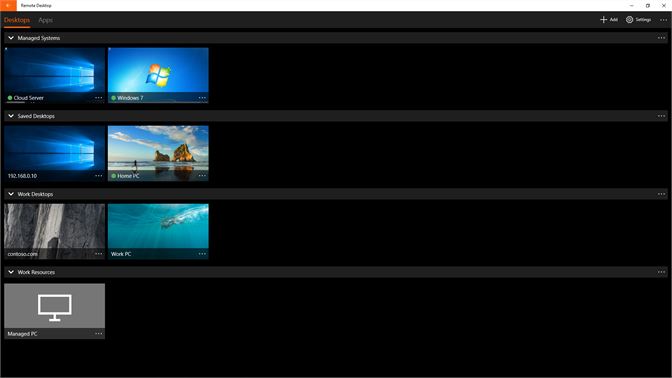In this article, we will see how to add or remove Remote Desktop users in Windows 10. This will allow them to make connections to the target computer over the Remote Desktop protocol. By default, only members of the Administrators group (e.g. Administrative accounts) have access to RDP. Before we continue, here. Since these tools are very specific to the Microsoft environment, most of them don't get released externally. About eight months ago, I came across a tool in the repository called Remote Desktop Connection Manager ('RDCMan' for short) written by Julian Burger, one of our principal developers on the Windows Live Experiences team. What worked for me was adding a local account in Windows (e.g., see Create a local user or administrator account in Windows 10; I called mine RDPUser with a password I assigned and also made the user an administrator) and then adding that login to remote desktop users. This does mean you will have a different login when logged in via remote. May 06, 2018 On the Windows PC you want to connect to remotely, download the Microsoft Remote Desktop assistant to configure your PC for remote access. Drivers xplore laptops & desktops.
- Log on as admin user with RDP
- Create a local (not Microsoft account) account with the name that would be before the @ (i.e. qwerty if the MS email were qwerty@outlook.com)
- Give to the created local user the “Remote Desktop Users” rights.
- Now log off as admin
- Remote desktop and use username .qwerty (note no @outlook.com)
- Now navigate to the new win10 settings user interface “PC Settings -> Users and Accounts ->” and link the local account with your Microsoft account.
- Log out
- Now log in using .qwerty@outlook.com
- If you want you can login as admin and give administrator rights to the user.
 -->
-->Applies to: Windows 10, Windows 8.1, Windows Server 2019, Windows Server 2016, Windows Server 2012 R2

You can control a remote PC by using a Microsoft Remote Desktop client. The client can run on almost any device, including on your mobile smartphone. The client gives you the same powers you would have if you could reach the PC's keyboard. Through the client, you can:
- Operate the apps that are installed on the PC.
- Access the files and network resources of the PC.
- Leave the apps open when you end the client.
Before you start, see the supported configuration article. The article discusses the PC configurations that the Remote Desktop clients can connect to. Also see the client FAQ article.

The following client apps are available:
| Client | Get the app | Documentation | Latest version |
|---|---|---|---|
| Windows Desktop | Windows Desktop client | Get started, What's new | 1.2.1844 |
| Microsoft Store | Windows 10 client in the Microsoft Store | Get started, What's new | 1.2.1810 |
| Android | Android client in Google Play | Get started, What's new | 10.0.10 |
| iOS | iOS client in the App Store | Get started, What's new | 10.2.5 |
| macOS | macOS client in the App Store | Get started, What's new | 10.6.1 |
Enable Remote Desktop Windows 10
Configuring the remote PC
To configure your remote PC before accessing it remotely, see Allow access to your PC.
Microsoft Remote Desktop Windows 10 Home

Remote Desktop client URI scheme
You can integrate features of Remote Desktop clients across platforms by enabling a Uniform Resource Identifier (URI) scheme. Learn about the supported URI attributes that you can use with the iOS, Mac, and Android clients.
